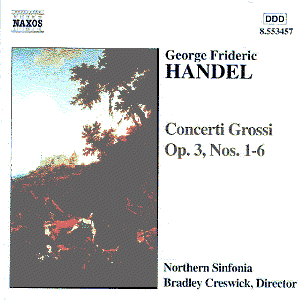George Frederick HANDEL
(1685-1759)
Concerti Grossi Opus 3
No 1 in B flat
Allegro, Largo, Allegro
No 2 in B flat
Vivace, Largo, Allegro, Moderato, Allegro
No 3 in G
Largo e staccato, Allegro, Adagio, Allegro
No 4 in F
Andante - Allegro, Andante, Allegro, Minuetto alternativo: Allegro
No 5 in D minor
Largo, Fuga: Allegro, Adagio, Allegro ma non troppo, Allegro
No 6 in D
Vivace, Allegro |
 |
 Northern
Sinfonia/Bradley Creswick (Conductor) Northern
Sinfonia/Bradley Creswick (Conductor)
Rec 2nd- 4th May 1995 The Jubilee Theatre, St Nicholas'
Hospital, Gosforth, Tyne and Wear
 NAXOS 8.553457
[54.03] NAXOS 8.553457
[54.03]
Crotchet
AmazonUK
AmazonUS
Amazon
recommendations |
With the established position of period instrument orchestras in the performance
of baroque music looking in recent years like a stranglehold it is interesting
to see what a modern orchestra like the Northern Sinfonia makes of the Concerti
Grossi opus 3 by Handel.
While there is much of beauty in the orchestral sound there are also major
issues concerning the performance style that are not dealt with so satisfyingly.
Modern orchestras always tend towards the problem of having a sound that
is simply too lush to provide the clarity of texture and line demanded by
baroque music. The Northern Sinfonia falls straight into this trap, especially
in the bass section. While it is true that baroque music must be led, musically,
from the basso continuo, that is not the same as simply allowing the bass
instruments to dominate the texture. Throughout this recording the basses
are over prominent, completely swamping a largely pointless harpsichord.
While it cannot be said that they are lugubrious or stolid, there being plenty
of agility in the passagework, this is at the expense of a more varied
articulation or phrasing. It is this omission that leads to the replacement
of "life" with mere "speed". The opening chord of the last movement in the
2nd concerto really sounds more like an ocean liner coming into
dock than a continuo section setting the pulse. In the second movement of
the same concerto, some very stylish playing by a pair of solo cellos is
similarly hampered through being unable to escape from the sounding morass
of string sound.
There are aspects of this recording that are more enjoyable. The fugue at
the end of the third concerto sets off with a more convincing sense of the
dance and some of the oboe solos provide a beauty of line that is undeniably
impressive. Throughout these works, Handel provides numerous solo sections
for a pair of oboes and these produce some of the highlights of the performance.
Personal preference would always be for the more open and buoyant sound of
baroque oboes, but the players of the Northern Sinfonia are at least able
to play with sprightly variety of articulation and some stylishly individual
ornamentation. The real highlight of this whole disc comes in the last track,
the 2nd movement of the D major concerto. Here, an unidentified
organist produces a masterclass of stylish playing with subtlety and grace
as well as a marvelous sense of the imaginative in ornamentation. In comparison
with this the stolid mordents of the flute soloist and the ripieno violins
sounds as tasteless as the organ sounds brilliant.
Overall there are good illustrations here of why this repertoire has become
so much the preserve of the period instrument groups. The lightness and
flexibility of baroque strings is always going to have the advantage in this
sort of music over long bows and a manner of playing that emphasises the
legato over rhythmic. While recordings like that of the English concert under
Trevor Pinnock are still in the catalogue, they represent a more enjoyable
Handelian experience.
Peter Wells
|
|

